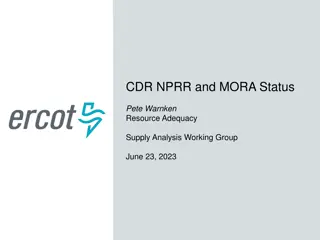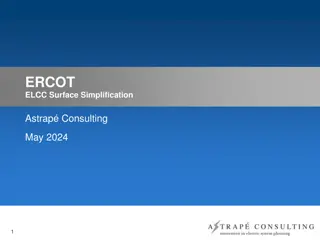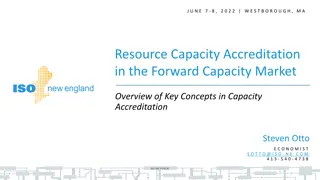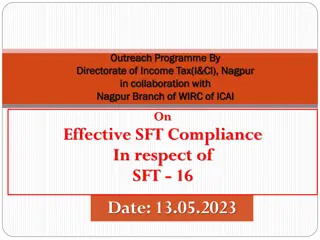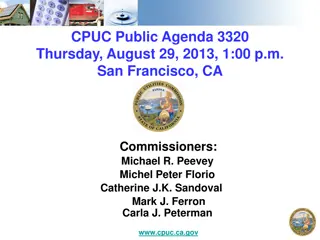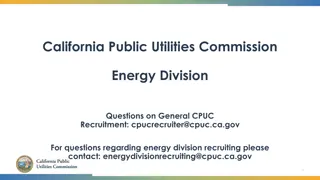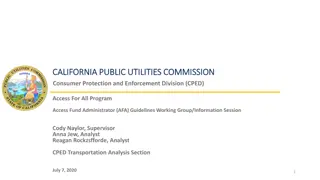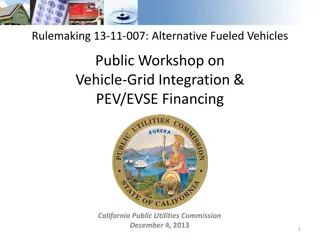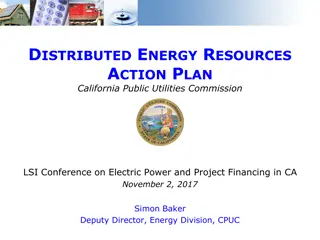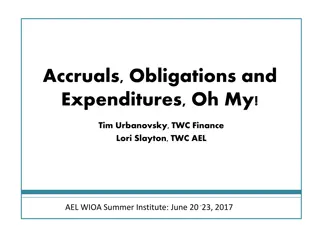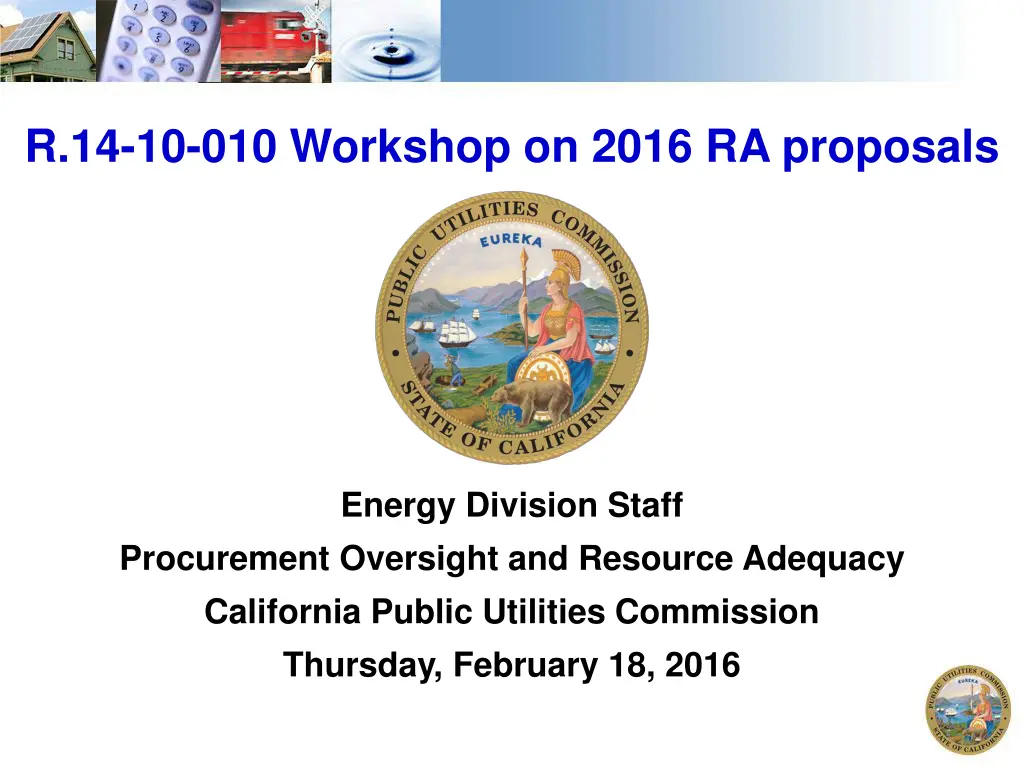
Workshop on 2016 RA Proposals at CPUC Energy Division
Join the workshop on 2016 RA proposals by CPUC Energy Division. Learn about RA obligations, ELCC, demand response, and more. Stay informed and participate in the discussions.
Download Presentation

Please find below an Image/Link to download the presentation.
The content on the website is provided AS IS for your information and personal use only. It may not be sold, licensed, or shared on other websites without obtaining consent from the author. If you encounter any issues during the download, it is possible that the publisher has removed the file from their server.
You are allowed to download the files provided on this website for personal or commercial use, subject to the condition that they are used lawfully. All files are the property of their respective owners.
The content on the website is provided AS IS for your information and personal use only. It may not be sold, licensed, or shared on other websites without obtaining consent from the author.
E N D
Presentation Transcript
R.14-10-010 Workshop on 2016 RA proposals Energy Division Staff Procurement Oversight and Resource Adequacy California Public Utilities Commission Thursday, February 18, 2016 1
Evacuation Procedure In the event of an emergency evacuation, please calmly proceed out the nearest exit. Bathrooms are located in the lobby by the cafeteria and in the lobby by the auditorium. 2
Remote Access Please place yourself on mute, and remain on mute unless you are asking a question To mute / unmute press *6 PLEASE DO NOT PUT YOUR LINE ON HOLD! Thursday February 18, 2016 10 am 4:30 pm To join by phone: Call-in: (866) 811-4174 Participant: 4390072 WebEx information: Meeting Number: 745 135 759 Meeting Password: !Energy1 CPUC Auditorium To start or join the online meeting: https://van.webex.com/van/j.php?MTID=m9b 75f714cec33281340bfd0393fec437 3
Suggested Etiquette for Today Thank you all for your time and participation We will have periodic stretch breaks and a lunch break during the course of the workshop Come and go or stand up and stretch as needed, but please take all conversations and phone calls outside I will stop for questions periodically please wait until I ask for questions For those on the phone please send your question as a chat to WebEx, and I will read it aloud then answer it 4
Agenda for today Introductions/Announcements Establishment of RA Obligations and ELCC (ED staff) Development of Coincidence Adjustment (CEC Staff) Lunch Demand Response Dispatch and Notification (ED staff/SCE/CAISO) Load Impact Protocols (ED staff and Joint DR Parties) Other Party Proposals (PG&E staff) 5
Summary - RA Obligations and ELCC Current Status - revisions to inputs and methods since draft results (July 2015) Establishment of RA obligations Establishment of Average Solar ELCC and Average Wind ELCC Locational and Technological Granularity Monthly Shaping and Phase-in Schedule 6
Summary of Proposed Results ED proposes not to alter the PRM Installed Capacity Requirement equal to month specific peak load plus 15%-17% ED proposes that capacity credit of solar resources should equal to monthly shaped average of 57.8% of installed capacity ED proposes that capacity credit of wind resources be equal to monthly shaped average of 12.6% of installed capacity 7
Current Status Draft results published in July 2015 Not official proposal; workshop in Aug 2015 Proposed results issued to R.14-10-010 service list Jan 15th, 2016 Energy Division proposes to set RA obligations and ELCC for wind and solar Workshop Discussion Comments and Reply Comments Likely Revised Proposal March 11 with added results 8
Review - Sequential Process Solar ELCC SoCal Step 3A Existing System unknown reliability Step 2A Add/Subtract actual Capacity Solar ELCC System Solar ELCC NorCal Step 0 0.1 Weighted Average LOLE Calibrated RA requirements Remove Solar/Wind, add Perfect Capacity until 0.1 Weighted Average LOLE Wind ELCC SoCal Step 3B Step 1 Wind ELCC system Note - In these slides, 0.1 LOLE refers to probability weighted average 0.1 LOLE across all 165 study cases. Wind ELCC NorCal Step 2B We are working on Step 3a and 3B right now 9
Revisions to Study Inputs Full conversion to TEPPC v1.5 conformance and cleaning of generator list Added new wind/solar that reached COD totals reflected in proposal Changed from import limits derived from 2024 CAISO study to import limits from RA import allocations Scaled yearly load shapes to annual peak load AND total energy instead of just scaling to peak load load stretching algorithm 10
Revisions to Import Limits Max Avail Import (MW) Revision to study assumptions to reflect historical flows instead of path ratings resulted in decreased import and export transfers Import into CAISO areas 24,291 Export from CAISO areas 24,134 Draft PLEXOS values (MW) Import into CAISO areas 36,861 Export from CAISO areas 38,163 Differences (MW) Decreased import 12,570 Decreased Export 14,029 11
Loads and Resources Calibrated 2017 Effective Resource Breakdown Base Case PGE Valley 13,787 24,828 23,709 2,300 9,052 2,798 Region Annual Peak Load Total Nameplate Resources Total Effective Resources Nuclear Resources Fossil Resources Peaking Resources Run of River Hydro Resources Scheduled Hydro Resources Emergency Hydro Resources Pumped Storage Resources Demand Response Resources Renewable Resources Effective Capacity /Peak Load 12 SDGE PGE Bay 8,695 7,604 6,226 SCE CAISO 48,060 62,885 56,029 2,923 28,004 8,205 4,812 5,538 4,907 23,878 24,915 20,888 623 11,337 2,866 132 972 200 590 1,270 2,898 89.90% 116.58% 0 0 3,227 1,074 4,388 1,467 0 0 0 0 0 0 0 374 5,586 461 1,218 731 1,208 505 6,558 661 1,848 2,220 5,105 40 43 798 177 201 102.17% 71.24% 171.95%
Scaling of Load Shapes Draft results showed distortion of load shapes by simply scaling to peak load. Want to preserve historical load shapes At the same time, want to transform load shape to match forecast peak and average Use linear transformation: ??= ???+ ? Peak 13
Establishment of RA Obligations RA obligations currently start with CEC monthly peak load forecasts and add a static PRM (15% - 17%) to peak load each month LOLE studies determine amount of Effective Capacity (EC) needed to maintain LOLE of 0.1 across year, given peak load and energy shapes for each study region PRM is post processing step, not study result PRM concept versus EC concept Important difference in how RA obligation is conceptualized 14
Draft Results vs. Final Results Calibrated Base Case Draft Results from July 2015 Final Results from Jan 2016 LOLE is spread out across months and larger in SDGE due to different resource portfolios/retirements. Load scaled differently - more extreme years produce more LOLE Month CAISO SCE SDGE PGE_Bay PGE_Valley 1 2 3 4 5 6 7 8 9 10 11 12 0.000 0.000 0.000 0.000 0.000 0.000 0.000 0.000 0.000 0.000 0.000 0.000 0.000 0.000 0.000 0.000 0.000 0.000 0.000 0.000 0.000 0.000 0.000 0.000 0.000 0.000 0.000 0.000 0.000 0.000 0.032 0.021 0.013 0.004 0.000 0.061 0.038 0.034 0.002 0.000 0.009 0.001 0.008 0.000 0.000 0.002 0.000 0.002 0.000 0.000 0.000 0.000 0.000 0.000 0.000 0.000 0.000 0.000 0.000 0.000 15
Load Shapes with Highest LOLE Final Results Scaled to Peak and Energy LOLE more spread out across load shapes and less focused in most extreme years Draft Results Scaled to Peak 16
Draft Vs. Final ELCC Values Increase in solar and wind capacity since draft results published incremental increase in Perfect Capacity needed to return LOLE to 0.1. Solar ELCC decreased from 63% to 57.8% and wind ELCC held steady at 12.6% 17
LOLE Studies Create Annual Values Sample of Annual LOLE generation to load comparison. Chart is illustrative and not actual values Studies performed to test LOLE for capacity requirements hold capacity level relatively steady throughout the year surplus of generation in offpeak months. 18
Next Steps to March 11 Revised Proposal ED staff will issue a final Inputs and Assumptions document incorporating the changes made in the January proposal ED staff intends to develop complete the work of breaking the solar and wind ELCC values into locations (Northern and Southern CA for solar, Altamont, Tehachapi and San Gorgonio for wind) More study will be ongoing, to be proposed for the 2018 RA compliance year 20
Implementation Proposal Energy Division staff intend to review and revise ELCC values and the Effective Capacity Requirement at least every two years Energy Division staff intends to propose adoption of assumptions and inputs via the RA proceeding whenever changes are proposed 21
Thank you! For Additional Information: www.cpuc.ca.gov 22



